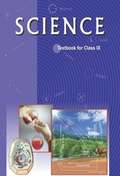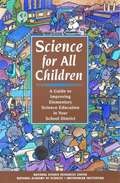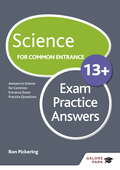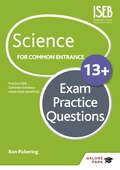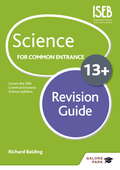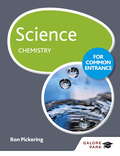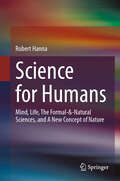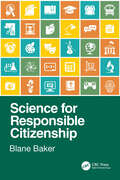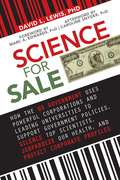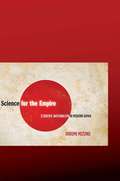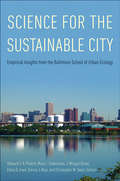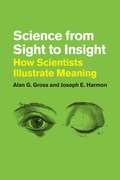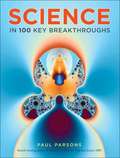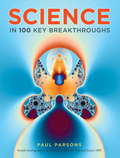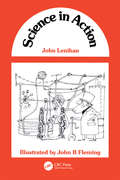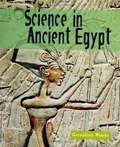- Table View
- List View
Science class 8 - Tamil Nadu Board: அறிவியல் எட்டாம் வகுப்பு
by State Council of Educational Research and Training Tamil Naduதற்போதைய வகுப்பில், அறிவியல் பாடத்தின் அனைத்து முக்கிய தலைப்புகளையும் உள்ளடக்கியதாக புது பயிலும் வழிகாட்டி வகுப்புகள் வழங்கப்பட்டுள்ளன. உடல் மற்றும் பொருளின் அடிப்படை அமைப்புகள், உயிரியல், வேதியியல் மற்றும் இயற்பியல் ஆகிய பிரிவுகளை அடிப்படையாகக் கொண்டு பாடம் முன்னெடுக்கப்படுகிறது. மாணவ/மாணவிகளுக்கான செயல்பாட்டு பரிசோதனைகள், விளக்கங்கள் மற்றும் எளிய விளக்கங்களுடன் கொடுக்கப்பட்டுள்ளன. உயிரின் வளர்ச்சி, சுற்றுச்சூழலுடன் உறவாடல் மற்றும் அறிவியல் நவீன தேசங்களின் முன்னேற்றம் ஆகியவை கற்றுக்கொள்ள முக்கியமான அம்சங்களாக இருக்கின்றன.
Science class 9 - NCERT - 23
by National Council of Educational Research and TrainingThe Class 9 Science textbook by NCERT provides a comprehensive exploration of fundamental scientific concepts. Divided into chapters covering topics like matter, motion, energy, and biology, it offers clear explanations supported by diagrams and examples. Emphasizing critical thinking and practical application, the textbook encourages students to engage in scientific inquiry and experimentation. It includes activities, experiments, and questions to reinforce learning and assess understanding. By fostering a deeper appreciation for science and its principles, the textbook equips students with the knowledge and skills necessary for further studies and real-world applications.
Science class 9 - Tamil Nadu Board
by Government of Tamil NaduThis book is developed in a holistic approach which inculcates comprehending and analytical skills. It will be helpful for the students to understand higher secondary science in a better way and to prepare for competitive exams in future. This textbook is designed in a learner centric way to trigger the thought process of students through activities and to make them excel in learning science.
Science for All Children: A Guide to Improving Elementary Science Education in Your School District
by National Academy of Sciences Staff Smithsonian Institution StaffRemember the first time you planted a seed and watched it sprout? Or explored how a magnet attracted a nail? If these questions bring back memories of joy and wonder, then you understand the idea behind inquiry-based science--an approach to science education that challenges children to ask questions, solve problems, and develop scientific skills as well as gain knowledge. Inquiry-based science is based on research and experience, both of which confirm that children learn science best when they engage in hands-on science activities rather than read from a textbook.The recent National Science Education Standards prepared by the National Research Council call for a revolution in science education. They stress that the science taught must be based on active inquiry and that science should become a core activity in every grade, starting in kindergarten. This easy-to-read and practical book shows how to bring about the changes recommended in the standards. It provides guidelines for planning and implementing an inquiry-based science program in any school district.The book is divided into three parts. "Building a Foundation for Change," presents a rationale for inquiry-based science and describes how teaching through inquiry supports the way children naturally learn. It concludes with basic guidelines for planning a program.School administrators, teachers, and parents will be especially interested in the second part, "The Nuts and Bolts of Change." This section describes the five building blocks of an elementary science program: Community and administrative support. A developmentally appropriate curriculum. Opportunities for professional development. Materials support. Appropriate assessment tools. Together, these five elements provide a working model of how to implement hands-on science.The third part, "Inquiry-Centered Science in Practice," presents profiles of the successful inquiry-based science programs in districts nationwide. These profiles show how the principles of hands-on science can be adapted to different school settings.If you want to improve the way science is taught in the elementary schools in your community, Science for All Children is an indispensable resource.
Science for Children
by Marilyn FleerScience for Children introduces readers to the pedagogy of primary and early childhood science education. The book pays special attention to the three strands of science, in accordance with the Australian Curriculum. <P><P>It also uses the practice principles and learning outcomes of the national Early Years Learning Framework to present content for babies through to the transition into the Foundation year at school. Science for Children explores various approaches to teaching and learning in science. It covers inquiry approaches in detail; makes explicit links to the 5Es; critiques longstanding approaches, such as discovery approaches and a transmission approach; and explores Indigenous perspectives and a Vygotskian framework. This allows the reader to make informed choices about when to use a particular approach in primary classrooms and early childhood settings. Designed to prepare future educators for practice, Science for Children challenges students and offers practical classroom-based strategies for their science teaching careers.
Science for Common Entrance 13+ Exam Practice Answers (for the June 2022 exams)
by Ron PickeringPlease note, this resource is suitable for the exams up to June 2022. New revision resources will be available from Spring 2022 for the exams from November 2022.Exam Board: ISEBLevel: 13+Subject: ScienceFirst Teaching: September 2015First Exam: Autumn 2018Confidently mark answers to the Science for Common Entrance 13+ Exam Practice Questions with worked examples, exam advice and tips for achieving the best results- Helps pupils to refine answers with guidance and worked examples- Includes ISEB Common Entrance mark scheme and advice for achieving top marks- Suitable for all ISEB Science 13+ Common Entrance exams taken from Autumn 2017 onwardsAlso available to purchase from the Galore Park website www.galorepark.co.uk:- Science for Common Entrance 13+ Exam Practice Answers- Science for Common Entrance 13+ Exam Practice Questions- Science for Common Entrance 13+ Revision Guide- Science for Common Entrance: Biology- Science for Common Entrance: Biology Answers- Science for Common Entrance: Chemistry- Science for Common Entrance: Chemistry Answers- Science for Common Entrance: Physics- Science for Common Entrance: Physics Answers
Science for Common Entrance 13+ Exam Practice Questions (for the June 2022 exams)
by Ron PickeringPlease note, this resource is suitable for the exams up to June 2022. New revision resources will be available from Spring 2022 for the exams from November 2022.Exam Board: ISEBLevel: 13+Subject: ScienceFirst Teaching: September 2015First Exam: Autumn 2018Practise 13+ Science with this wealth of exam-style questions that have been designed to reflect the style and level of the ISEB Common Entrance Science exam. The range of questions helps pupils improve their exam technique and provides realistic practice for Biology, Chemistry and Physics exams at 13+.- Covers every 13+ topic for Biology, Chemistry and Physics- Familiarises pupils with the type of questions they will face in the exam- Identifies strengths and weaknesses using topic-based exercises- Suitable for ISEB 13+ Mathematics Common Entrance exams taken from Autumn 2017 onwardsAlso available to purchase from the Galore Park website www.galorepark.co.uk:- Science for Common Entrance 13+ Exam Practice Answers- Science for Common Entrance 13+ Revision Guide- Science for Common Entrance: Biology- Science for Common Entrance: Biology Answers- Science for Common Entrance: Chemistry- Science for Common Entrance: Chemistry Answers- Science for Common Entrance: Physics- Science for Common Entrance: Physics Answers
Science for Common Entrance 13+ Revision Guide (for the June 2022 exams)
by Richard BaldingPlease note, this resource is suitable for the exams up to June 2022. New revision resources will be available from Spring 2022 for the exams from November 2022.Exam Board: ISEBLevel: 13+Subject: ScienceFirst Teaching: September 2015First Exam: Autumn 2017Revise every topic and theory tested in the ISEB 13+ Common Entrance exams for Biology, Chemistry and Physics. This essential revision tool covers all the content of the new ISEB 13+ Common Entrance syllabus for Biology, Chemistry and Physics. The knowledge required for the exam is integrated with practical exam tips and advice to make revision easier and more effective.- Consolidates revision with all key information in one place- Ensures pupils have covered everything with the handy revision checklist- 'Test yourself' exercises identify areas requiring further study- Suitable for ISEB 13+ Science Common Entrance exams taken from Autumn 2017 onwardsAlso available to purchase from the Galore Park website www.galorepark.co.uk:- Science for Common Entrance 13+ Exam Practice Answers- Science for Common Entrance 13+ Exam Practice Questions- Science for Common Entrance: Biology- Science for Common Entrance: Biology Answers- Science for Common Entrance: Chemistry- Science for Common Entrance: Chemistry Answers- Science for Common Entrance: Physics- Science for Common Entrance: Physics Answers
Science for Common Entrance: Biology
by W. R. PickeringCover everything required for the 13+ Common Entrance Biology exam with clearly presented content, lively illustrations and challenging end-of-chapter questions. This challenging and stimulating Science course has been reviewed by the ISEB subject editor and covers the content of both Levels 1 and 2 of the 13+ Biology exam. Designed for pupils in Years 7 and 8, it is an indispensable resource that lays the foundations for Common Entrance success. - Explores every Level 1 and 2 topic with clear explanations and examples - Includes topic-based exercises and extension questions - Builds on previous study with preliminary knowledge sections Also available: - Science for Common Entrance: Biology Answers - Science for Common Entrance: Chemistry - Science for Common Entrance: Chemistry Answers - Science for Common Entrance: Physics - Science for Common Entrance: Physics Answers - Science for Common Entrance 13+ Exam Practice Answers - Science for Common Entrance 13+ Exam Practice Questions - Science for Common Entrance 13+ Revision Guide
Science for Common Entrance: Chemistry
by W. R. PickeringThis challenging and stimulating Science course has been reviewed by the ISEB subject editor and covers the content of both Levels 1 and 2 of the 13+ Chemistry exam. Designed for pupils in Years 7 and 8, it is an indispensable resource that lays the foundations for Common Entrance success. - Explores every Level 1 and 2 topic with clear explanations and examples - Includes topic-based exercises and extension questions - Builds on previous study with preliminary knowledge sections - Suitable for ISEB 13+ Mathematics Common Entrance exams taken from Autumn 2017 onwards Also available to purchase from the Galore Park website www.galorepark.co.uk: - Science for Common Entrance: Chemistry Answers - Science for Common Entrance: Biology - Science for Common Entrance: Biology Answers - Science for Common Entrance: Physics - Science for Common Entrance: Physics Answers - Science for Common Entrance 13+ Exam Practice Answers - Science for Common Entrance 13+ Exam Practice Questions - Science for Common Entrance 13+ Revision Guide
Science for Humans: Mind, Life, The Formal-&-Natural Sciences, and A New Concept of Nature
by Robert HannaThis book presents and defends an original and paradigm-shifting conception of formal science, natural science, and the natural universe alike, that’s fully pro-science, but at the same time neither theological or God-centered, nor solipsistic or self-centered, nor communitarian or social-institution-centered, nor scientistic or science-valorizing, nor materialist/physicalist or reductive, nor—above all—mechanistic. It does this by presenting and defending what Robert Hanna calls the neo-organicist turn, including manifest realism and the three sub-parts of metaphysical organicism: liberal naturalism, mind-life continuity, and explanatory inversion, whereby mechanical systems are explained by grounding them in organic systems, and not the other way around. Or more briefly and simply put, the purpose of this book is to present and defend science for humans. As such, it will be highly interesting and profoundly relevant to graduate students and specialist researchers in philosophy and the formal-&-natural sciences.
Science for Responsible Citizenship
by Blane BakerScience for Responsible Citizenship helps the reader to understand how science works and how science can help us develop reasonable and logical solutions to worldwide problems. Basic science knowledge and possible solutions based on scientific reasoning are explored, with a focus on interdisciplinary topics including disease transmission, energy, and climate change. The book starts with discussing the role of science in modern society, before tackling the basic science of global warming, human health, chemical processes that contribute to life on Earth, and the importance of water. The second half of the book describes the science of the electrical grid, nuclear reactions, devices and reactors, the Earth’s habitability, electronics, and optics, and concludes with a look ahead at the scientific and technological challenges of future energy needs and sustainable energy. This book can be used as part of a general science course at the college level and is also accessible to anyone with a high school background.Key Features: Addresses the fundamentals of scientific knowledge and reasoning in a clear and accessible style Offers a timely exploration of several existential challenges that can be addressed by science Provokes and encourages thought on how to solve some of our global problems
Science for Sale: How the US Government Uses Powerful Corporations and Leading Universities to Support Government Policies, Silence Top Scientists, Jeopardize Our Health, and Protect Corporate Profits
by David L. LewisWhen Speaker Newt Gingrich greeted Dr. David Lewis in his office overlooking the National Mall, he looked at Dr. Lewis and said: "You know you're going to be fired for this, don't you?" "I know," Dr. Lewis replied, "I just hope to stay out of prison." Gingrich had just read Dr. Lewis's commentary in Nature, titled "EPA Science: Casualty of Election Politics." Three years later, and thirty years after Dr. Lewis began working at EPA, he was back in Washington to receive a Science Achievement Award from Administrator Carol Browner for his second article in Nature. By then, EPA had transferred Dr. Lewis to the University of Georgia to await termination--the Agency's only scientist to ever be lead author on papers published in Nature and Lancet.The government hires scientists to support its policies; industry hires them to support its business; and universities hire them to bring in grants that are handed out to support government policies and industry practices. Organizations dealing with scientific integrity are designed only to weed out those who commit fraud behind the backs of the institutions where they work. The greatest threat of all is the purposeful corruption of the scientific enterprise by the institutions themselves. The science they create is often only an illusion, designed to deceive; and the scientists they destroy to protect that illusion are often our best. This book is about both, beginning with Dr. Lewis's experience, and ending with the story of Dr. Andrew Wakefield.
Science for Sale: How the US Government Uses Powerful Corporations and Leading Universities to Support Government Policies, Silence Top Scientists, Jeopardize Our Health, and Protect Corporate Profits
by David L. LewisFor the first time in paperback and with a new introduction. Discover how and why the government is corrupting scientific research.When Speaker Newt Gingrich greeted Dr. David Lewis in his office overlooking the National Mall, he looked at Dr. Lewis and said: "You know you’re going to be fired for this, don’t you?” "I know,” Dr. Lewis replied, "I just hope to stay out of prison.” Gingrich had just read Dr. Lewis’s commentary in Nature, titled "EPA Science: Casualty of Election Politics.” Three years later, and thirty years after Dr. Lewis began working at EPA, he was back in Washington to receive a Science Achievement Award from Administrator Carol Browner for his second article in Nature. By then, EPA had transferred Dr. Lewis to the University of Georgia to await termination—the Agency’s only scientist to ever be lead author on papers published in Nature and Lancet.The government hires scientists to support its policies; industry hires them to support its business; and universities hire them to bring in grants that are handed out to support government policies and industry practices. Organizations dealing with scientific integrity are designed only to weed out those who commit fraud behind the backs of the institutions where they work. The greatest threat of all is the purposeful corruption of the scientific enterprise by the institutions themselves. The science they create is often only an illusion, designed to deceive; and the scientists they destroy to protect that illusion are often our best. This book is about both, beginning with Dr. Lewis’s experience, and ending with the story of Dr. Andrew Wakefield. This new edition, now for the first time in paperback, features a new introduction by the author.
Science for the Empire
by Hiromi MizunoMizuno (history, U. of Minnesota) explores the relationship between discourses of science, nationalism, and modernity in Imperial Japan, particularly focusing on competing promotions of science amongst Japanese technology-bureaucrats, Marxist intellectuals, and popular science writers engaged in the developing the new genre of popular science (tsuzoku kagagku) journalism and how those competing visions were eventually co-opted and mobilized by the Imperial state in support of wartime objectives. Annotation ©2009 Book News, Inc. , Portland, OR (booknews. com)
Science for the Sustainable City: Empirical Insights from the Baltimore School of Urban Ecology
by J. Morgan Grove Mary L. Cadenasso Steward T. A. Pickett Elena G. Irwin Emma J. Rosi Christopher M. SwanA presentation of key findings and insights from over two decades of research, education, and community engagement in the acclaimed Baltimore Ecosystem Study In a world of more than seven billion people—who mostly reside in cities and towns—the Baltimore Ecosystem Study is recognized as a pioneer in modern urban social-ecological science. After two decades of research, education, and community engagement, there are insights to share, generalizations to examine, and research needs to highlight. This timely volume synthesizes the key findings, melds the perspectives of different disciplines, and celebrates the benefits of interacting with diverse communities and institutions in improving Baltimore’s ecology. These widely applicable insights from Baltimore contribute to our understanding the ecology of other cities, provide a comparison for the global process of urbanization, and inform establishment of urban ecological research elsewhere. Comprehensive, interdisciplinary, and highly original, it gives voice to the wide array of specialists who have contributed to this living urban laboratory.
Science from Sight to Insight: How Scientists Illustrate Meaning
by Alan G. Gross Joseph E. HarmonJohn Dalton's molecular structures. Scatter plots and geometric diagrams. Watson and Crick's double helix. The way in which scientists understand the world--and the key concepts that explain it--is undeniably bound up in not only words, but images. Moreover, from PowerPoint presentations to articles in academic journals, scientific communication routinely relies on the relationship between words and pictures. In Science from Sight to Insight, Alan G. Gross and Joseph E. Harmon present a short history of the scientific visual, and then formulate a theory about the interaction between the visual and textual. With great insight and admirable rigor, the authors argue that scientific meaning itself comes from the complex interplay between the verbal and the visual in the form of graphs, diagrams, maps, drawings, and photographs. The authors use a variety of tools to probe the nature of scientific images, from Heidegger's philosophy of science to Peirce's semiotics of visual communication. Their synthesis of these elements offers readers an examination of scientific visuals at a much deeper and more meaningful level than ever before.
Science from Sight to Insight: How Scientists Illustrate Meaning
by Alan G. Gross Joseph E. HarmonJohn Dalton’s molecular structures. Scatter plots and geometric diagrams. Watson and Crick’s double helix. The way in which scientists understand the world—and the key concepts that explain it—is undeniably bound up in not only words, but images. Moreover, from PowerPoint presentations to articles in academic journals, scientific communication routinely relies on the relationship between words and pictures. In Science from Sight to Insight, Alan G. Gross and Joseph E. Harmon present a short history of the scientific visual, and then formulate a theory about the interaction between the visual and textual. With great insight and admirable rigor, the authors argue that scientific meaning itself comes from the complex interplay between the verbal and the visual in the form of graphs, diagrams, maps, drawings, and photographs. The authors use a variety of tools to probe the nature of scientific images, from Heidegger’s philosophy of science to Peirce’s semiotics of visual communication. Their synthesis of these elements offers readers an examination of scientific visuals at a much deeper and more meaningful level than ever before.
Science in 100 Key Breakthroughs
by Paul ParsonsScience in 100 Key Breakthroughs presents a series of clear and concise essays that explain the fundamentals of some of the most exciting and important science concepts you really need to know. Paul Parsons profiles the important, ground-breaking, and front-of-mind scientific discoveries that have had a profound influence on our way of life and will grow in importance with our advancing understanding.In 100 sections, this book provides an overview of the history of Western science, from astronomy and physics to geology, biology and psychology and everything in between. Starting with the origins of counting more than 35,000 years ago, Science tells a rich and fascinating story of discovery, invention, gradual progress and inspired leaps of the imagination. Many key concepts and discoveries are defined and discussed including: The circumference of the Earth, Chaos theory, Algebra, Relativity, Newton's Principia, Brownian motion, Pi, Wave/particle duality, Germ theory, The computer, X-rays, The double helix, Viruses, The human genomeReadable, informative and thought-provoking, this is the ideal introduction to cutting-edge science and the essential overview for anyone who wants to learn more about these often daunting but increasingly essential subjects.
Science in 100 Key Breakthroughs
by Paul ParsonsScience in 100 Key Breakthroughs presents a series of clear and concise essays that explain the fundamentals of some of the most exciting and important science concepts you really need to know. Paul Parsons profiles the important, ground-breaking, and front-of-mind scientific discoveries that have had a profound influence on our way of life and will grow in importance with our advancing understanding. In 100 sections, this book provides an overview of the history of Western science, from astronomy and physics to geology, biology and psychology and everything in between. Starting with the origins of counting more than 35,000 years ago, Science in 100 Key Breakthroughs tells a rich and fascinating story of discovery, invention, gradual progress and inspired leaps of the imagination. Many key concepts and discoveries are defined and discussed including: The circumference of the Earth, Chaos theory, Algebra, Relativity, Newton's Principia, Brownian motion, Pi, Wave/particle duality, Germ theory, The computer, X-rays, The double helix, Viruses, The human genome. Readable, informative and thought-provoking, this is the ideal introduction to cutting-edge science and the essential overview for anyone who wants to learn more about these often daunting but increasingly essential subjects.
Science in 100 Key Breakthroughs
by Paul ParsonsScience in 100 Key Breakthroughs presents a series of clear and concise essays that explain the fundamentals of some of the most exciting and important science concepts you really need to know. Paul Parsons profiles the important, ground-breaking, and front-of-mind scientific discoveries that have had a profound influence on our way of life and will grow in importance with our advancing understanding. In 100 sections, this book provides an overview of the history of Western science, from astronomy and physics to geology, biology and psychology and everything in between. Starting with the origins of counting more than 35,000 years ago, Science in 100 Key Breakthroughs tells a rich and fascinating story of discovery, invention, gradual progress and inspired leaps of the imagination. Many key concepts and discoveries are defined and discussed including: The circumference of the Earth, Chaos theory, Algebra, Relativity, Newton's Principia, Brownian motion, Pi, Wave/particle duality, Germ theory, The computer, X-rays, The double helix, Viruses, The human genome. Readable, informative and thought-provoking, this is the ideal introduction to cutting-edge science and the essential overview for anyone who wants to learn more about these often daunting but increasingly essential subjects.
Science in Action
by John LenihanIn Science in Action, John Lenihan shares his irrepressible enthusiasm for science. With characteristic wit and humor, he explains how science affects our daily lives in diverse areas such as medicine, poetry, politics, the environment, and the paranormal-cheerfully debunking some popular pseudo-scientific myths along the way. John Fleming's delightful cartoons add wry comment to the text, making this a book enjoyable to read time and again.
Science in Action: How to Follow Scientists and Engineers Through Society
by Bruno LatourScience and technology have immense authority and influence in our society, yet their working remains little understood. The conventional perception of science in Western societies has been modified in recent years by the work of philosophers, sociologists and historians of science. In this book Bruno Latour brings together these different approaches to provide a lively and challenging analysis of science, demonstrating how social context and technical content are both essential to a proper understanding of scientific activity. Emphasizing that science can only be understood through its practice, the author examines science and technology in action: the role of scientific literature, the activities of laboratories, the institutional context of science in the modern world, and the means by which inventions and discoveries become accepted. From the study of scientific practice he develops an analysis of science as the building of networks. Throughout, Bruno Latour shows how a lively and realistic picture of science in action alters our conception of not only the natural sciences but also the social sciences and the sociology of knowledge in general. This stimulating book, drawing on a wealth of examples from a wide range of scientific activities, will interest all philosophers, sociologists and historians of science, scientists and engineers, and students of the philosophy of social science and the sociology of knowledge.
Science in Action: Science Project Guide (6th Edition)
by Corinne Sawtelle James Ridgley Colette Stancel Rick EndersWhile scientific investigations and projects are very important parts of science education, they don’t need to be scary. This project guide is a great help. Its step-by-step instructions walk your teen through planning, experimenting, reporting, and presenting the findings of a complete science project—with samples included. Also included in the project guide are helpful worksheets for selecting a topic and problem, getting started, and evaluating the investigation plan. The 7 grading forms are actually checklists that make your evaluation easy and thorough. Be prepared for a great learning experience! Gr. 7–11.
Science in Ancient Egypt (Science of the Past)
by Geraldine WoodsThe book discusses the achievements of the ancient Egyptians in science, mathematics, astronomy, agriculture, and technology.

